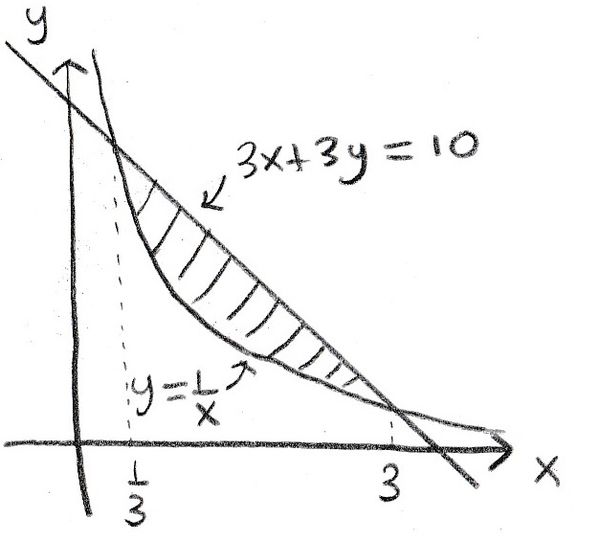Science:Math Exam Resources/Courses/MATH101/April 2014/Question 03
{{#incat:MER QGQ flag|{{#incat:MER QGH flag|{{#incat:MER QGS flag|}}}}}}
• Q1 (a) • Q1 (b) • Q1 (c) • Q1 (d) • Q1 (e) • Q1 (f) • Q1 (g) • Q1 (h) • Q1 (i) • Q1 (j) • Q1 (k) • Q2 • Q3 • Q4 • Q5 • Q6 • Q7 (a) • Q7 (b) • Q8 • Q9 (a) • Q9 (b) •
Question 03 |
|---|
|
Long Problem. Show your work. No credit will be given for the answer without the correct accompanying work. Find the volume of the solid generated by rotating the finite region bounded by and about the x-axis. It will be useful to sketch the region first. |
|
Make sure you understand the problem fully: What is the question asking you to do? Are there specific conditions or constraints that you should take note of? How will you know if your answer is correct from your work only? Can you rephrase the question in your own words in a way that makes sense to you? |
|
If you are stuck, check the hints below. Read the first one and consider it for a while. Does it give you a new idea on how to approach the problem? If so, try it! If after a while you are still stuck, go for the next hint. |
Hint 1 |
|---|
|
How can we express the volume generated by rotating a single function, , around the x-axis? |
Hint 2 |
|---|
|
If we think of the volume generated by each function separately, how can we isolate the volume between the functions? |
|
Checking a solution serves two purposes: helping you if, after having used all the hints, you still are stuck on the problem; or if you have solved the problem and would like to check your work.
|
{{#incat:MER CT flag||
}}

















![{\displaystyle V_{1}=\pi \int _{\frac {1}{3}}^{3}\left({\frac {10}{3}}-x\right)^{2}{\textrm {d}}x=\pi \int _{\frac {1}{3}}^{3}{\frac {100}{9}}-{\frac {20}{3}}x+x^{2}{\textrm {d}}x=\pi \left[{\frac {100}{9}}x-{\frac {10}{3}}x^{2}+{\frac {1}{3}}x^{3}\right]_{\frac {1}{3}}^{3}={\frac {728}{81}}\pi .}](https://wiki.ubc.ca/api/rest_v1/media/math/render/svg/2f285c79a330276bf45af3dce32327b1c14be6d5)
![{\displaystyle V_{2}=\pi \int _{\frac {1}{3}}^{3}\left({\frac {1}{x}}\right)^{2}{\textrm {d}}x=-\pi \left[{\frac {1}{x}}\right]_{\frac {1}{3}}^{3}={\frac {8}{3}}\pi .}](https://wiki.ubc.ca/api/rest_v1/media/math/render/svg/5186655320cd531730cc5e733bc33257170c31f6)

